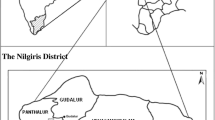Abstract
Landslide is a common natural hazard that usually occurs in mountainous areas. Rapid urban development and high traffic intensity movements have been hampered to a great extent by phenomenon of landslides. In Ghat section, vertical cuttings and steep slopes are induced slope failures. An assessment of landslide hazards is therefore a prerequisite for sustainable development of the hilly region. In the present study, Macro Landslide Hazard Zonation was carried out in the Bodi – Bodimettu ghats section, Western Ghats, Theni district. The slope spreads over an area of about 10.09 sq km encompassing Puliuttu Ar. sub-watershed. The study was made with help of different types of data including Survey of India topographic map, geology map, important inherent factors like lithology, structure, slope morphometry, relative relief, land use/land cover and hydrogeological conditions using Bureau of Indian Standard (BSI 14496 (Part 2):1998) and related thematic maps. Based on the thematic layers, landslide hazard evaluation factor (LHEF) and total estimated hazard (TEHD) were calculated and the macro hazard zonation map was prepared. Landslide Hazard Zonation (LHZ) of the terrain shows that out of 17 facets, facets 1 to 5 and 8 falls under Moderate Hazard zone category and facets 6, 7 and 9 to 17 under the High Hazard zone category. The field study with further analysis for hazard concluded that about 68% of the total area falls in the high hazard zone.







Similar content being viewed by others
References
Anbalagan, R. (1992). Landslide hazard evaluation and zonation mapping in mountainous Terrain. Engineering Geology, 32, 269–277.
Anbalagan, R. (1996). An overview of landslide hazards in Himalaya, available knowledge base, gaps, and recommendation for future research. Himalayan Geology, 17, 165–167.
Anbalagan, R., Singh, B., Chakraborty, D., & Kohli, A. (2007). A filed manual for landslide investigations. New Delhi: Department of Sciene and Technology.
Anbazhagan. S., & Saranathan. E. (2001). Structure and its Impact in Uthangarai and Thirthamalai region, Tamil Nadu, India – Using Remote sensing. Journal of Indian Society of Remote sensing, 29(4), 187–195.
Anon (1998). Bureau of Indian Standard, preparation of landslide hazard zonation maps in mountainous terrains-guidelines, part 2 Macro-zonation, IS 14496.
Anon. (2006). Manual of national land use and land cover mapping using multi temporal satellite data. Hyderabad: National Remote Sensing Centre.
Gupta, P., & Anbalagan, R. (1995). Landslide hazard zonation, mapping of TehriPratapnagar area, Garhwal Himalayas. Journal of Rock Mechanics and Tunnel Technology India, 1(1), 41–58.
Gupta, R. P., & Joshi, B. C. (1990). Landslide hazard zonation using the GIS approach – a case study from the Ramganga Catchment, Himalayas. Engineering Geology, 28, 119–131.
Gupta, V., Sah, M. P., Virdi, N. S., & Bartarya, S. K. (1993). Landslide hazard zonation in the Upper Satlej Valley, District Kinnaur, Himachal Pradesh. Journal of Himalayan Geology, 4, 81–93.
Gupta, R. P., Saha, A. K., Arora, M. K., & Kumar, A. (1999). Landslide hazard zonation in part of Bhagirathi Valley, Garhwal Himalaya, using integrated remote sensing – GIS. Himalayan Geology, 20, 71–85.
Nagarajan, R., Mukherjee, A., Roy, A., & Khire, M. V. (1998). Temporal remote sensing data and GIS Application in Landslide Hazard Zonation of part of Western Ghat, India. International Journal of Remote Sensing, 19(4), 573–585.
Pachauri, A. K., & Pant, M. (1992). Landslide hazard mapping based on geological attributes. Engineering Geology, 32, 81–100.
Ramasamy, S. M., & Muthukumar, M. (2008). Geospatial modelling of geosystems and landslides mapping and mitigation, The Nilgiri Mountains, South India. Indian Landslides, 1(1), 45–54.
Saha, A. K., Gupta, R. P., & Arora, M. K. (2002). GIS-based Landslide Hazard Zonation in the Bhgirathi (Ganga) valley, Himalayas. International Journal of Remote Sensing, 38(2), 357–369.
Sarkar, S., Kanungo, D. P., & Mehrotra, G. S. (1995). Landslide hazard zonation: a case study in Garhwal Himalaya, India. Mountain Research and Development, 15(4), 301–309.
Sharma, V. K. (2008). Macro-zonation of Landslide Hazard in the Environs of Baira Dam Project, Chamba District, Himachal Pradesh. Journal of the Geological Society of India, 71(3), 425–432.
Varnes, D. J. (1984). Landslide hazard zonation: A review of principles and practice (pp. 1–63). Paris: UNESCO.
Virdi, N. S., Sah, M. P., & Bartarya, S. K. (1997). Mass wasting its manifestation, causes and controls; some case histories from Himachal Himalaya. In D. K. Agrawal, V. Joshi, K. Kumar and L. M. S. Palni (Eds.), Perspectives of mountain risk Engineering in the Himalayan region (pp. 111–130). Nainital: Gyanodaya Prakashan.
Author information
Authors and Affiliations
Corresponding author
About this article
Cite this article
Kannan, M., Saranathan, E. & Anbalagan, R. Macro Landslide Hazard Zonation Mapping - Case Study from Bodi – Bodimettu Ghats Section, Theni District, Tamil Nadu - India. J Indian Soc Remote Sens 39, 485–496 (2011). https://doi.org/10.1007/s12524-011-0112-4
Received:
Accepted:
Published:
Issue Date:
DOI: https://doi.org/10.1007/s12524-011-0112-4




